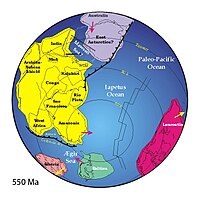
Photo from wikipedia
Significance The Late Ordovician mass extinction (LOME) terminated one of the greatest biodiversity radiations in Earth history eliminating ∼85% of marine animals, and it is coincident with the first major… Click to show full abstract
Significance The Late Ordovician mass extinction (LOME) terminated one of the greatest biodiversity radiations in Earth history eliminating ∼85% of marine animals, and it is coincident with the first major glaciation of the Phanerozoic. To evaluate LOME origins, we use uranium isotopes from marine limestones as a proxy for global-ocean redox conditions. Our results provide evidence of an abrupt global-ocean anoxic event coincident with the LOME onset and its continuation after the biologic recovery, through peak glaciation, and the following early Silurian deglaciation. These results also provide evidence for widespread ocean anoxia initiating and continuing during icehouse conditions. Widespread marine anoxia is hypothesized as the trigger for the second pulse of the Late Ordovician (Hirnantian) mass extinction based on lithologic and geochemical proxies that record local bottom waters or porewaters. We test the anoxia hypothesis using δ238U values of marine limestones as a global seawater redox proxy. The δ238U trends at Anticosti Island, Canada, document an abrupt late Hirnantian ∼0.3‰ negative shift continuing through the early Silurian indicating more reducing seawater conditions. The lack of observed anoxic facies and no covariance among δ238U values and other local redox proxies suggests that the δ238U trends represent a global-ocean redox record. The Hirnantian ocean anoxic event (HOAE) onset is coincident with the extinction pulse indicating its importance in triggering it. Anoxia initiated during high sea levels before peak Hirnantian glaciation, and continued into the subsequent lowstand and early Silurian deglacial eustatic rise, implying that major climatic and eustatic changes had little effect on global-ocean redox conditions. The HOAE occurred during a global δ13C positive excursion, but lasted longer indicating that controls on the C budget were partially decoupled from global-ocean redox trends. U cycle modeling suggests that there was a ∼15% increase in anoxic seafloor area and ∼80% of seawater U was sequestered into anoxic sediments during the HOAE. Unlike other ocean anoxic events (OAE), the HOAE occurred during peak and waning icehouse conditions rather than during greenhouse climates. We interpret that anoxia was driven by global cooling, which reorganized thermohaline circulation, decreased deep-ocean ventilation, enhanced nutrient fluxes, stimulated productivity, which lead to expanded oxygen minimum zones.
Journal Title: Proceedings of the National Academy of Sciences of the United States of America
Year Published: 2018
Link to full text (if available)
Share on Social Media: Sign Up to like & get
recommendations!